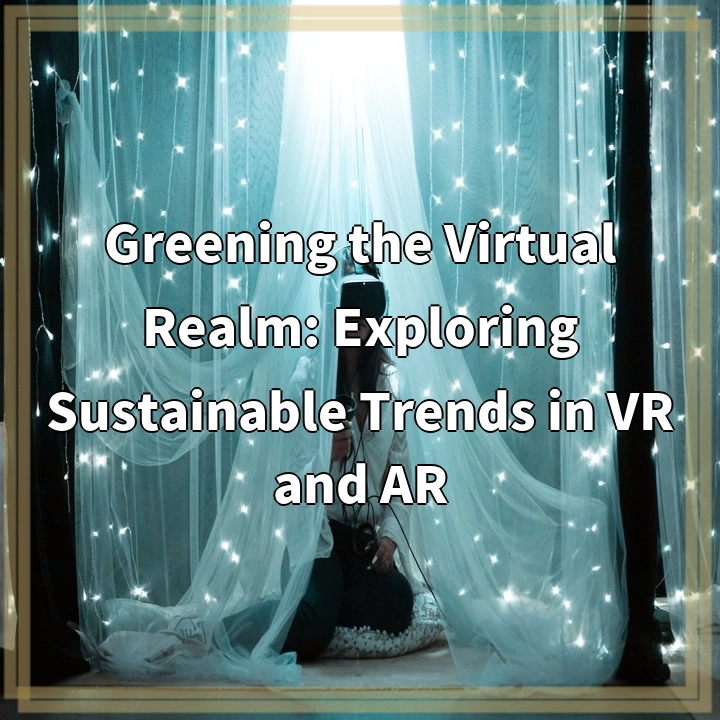
What it is:
Virtual Reality (VR) and Augmented Reality (AR) are rapidly emerging technologies that have transformed various industries. VR immerses users in a computer-generated simulation, while AR overlays digital information onto the real world. These technologies offer exciting possibilities for entertainment, education, healthcare, and more. However, as their popularity grows, it is crucial to examine their environmental impact and explore sustainable trends and practices to mitigate any negative effects.
Real-World Problems:
1. Energy Consumption:
One of the major concerns surrounding VR and AR is the significant energy consumption required to power the devices. High-performance processors, graphics cards, and displays demand substantial electricity, contributing to carbon emissions and fossil fuel consumption. As adoption rates increase, so does the demand for energy, putting pressure on power grids and exacerbating environmental challenges related to energy production and consumption.
2. Electronic Waste:
The rapid pace of technological advancements leads to frequent upgrades and replacements of VR and AR devices, resulting in a growing problem of electronic waste. The improper disposal of these gadgets can have harmful consequences, as they contain hazardous materials such as heavy metals and toxic chemicals. The responsible management and recycling of electronic waste are crucial to minimize the environmental impact and ensure the sustainability of these technologies.
3. Material Resources:
The production and manufacturing of VR and AR devices require significant amounts of raw materials, including metals, plastics, and rare earth elements. The extraction of these resources often has serious ecological and social consequences, such as deforestation, habitat destruction, and human rights abuses. Exploring alternative materials, adopting circular economy principles, and promoting device recycling can help reduce the environmental footprint associated with these technologies.
4. Virtual Travel and Carbon Footprint:
VR and AR offer the possibility of virtual travel experiences, allowing users to explore different places without physically traveling. While this can help reduce carbon emissions associated with transportation, it is essential to consider the energy and resource requirements of creating these virtual environments. Additionally, there may be unintended consequences on local economies and cultural heritage if virtual travel replaces actual visits. Striking a balance between virtual and real-world experiences is crucial to minimize negative environmental impacts.
5. E-Waste Recycling Challenges:
Given the specific components and intricacies of VR and AR devices, recycling and proper disposal can be challenging. These devices often contain a combination
of metals, plastics, and electronic components that require specialized recycling facilities. Increasing awareness and creating dedicated recycling programs for VR and AR devices are essential to prevent e-waste from ending up in landfills or being illegally shipped to developing countries for unsafe recycling practices.
In the next section, we will explore the various sustainable trends and practices that aim to address these real-world problems and make VR and AR more environmentally friendly and socially responsible.

Solutions: Greening the Virtual Realm
1. Energy-Efficient Hardware:
The development and use of energy-efficient hardware can significantly reduce the power consumption of VR and AR devices. Manufacturers can prioritize the use of low-power components, optimize software algorithms, and implement power management features to extend battery life and minimize energy usage. Additionally, research into renewable energy sources for device charging can further reduce the carbon footprint of these technologies.
2. Extended Device Lifespan:
Promoting device longevity through software updates, modular designs, and repairability can help reduce electronic waste. Manufacturers can prioritize longer support periods and provide repair guides and spare parts to extend the lifespan of VR and AR devices. Additionally, the collaboration between manufacturers, recyclers, and consumers is vital to establish effective take-back programs and ensure proper recycling and disposal of end-of-life devices.
3. Sustainable Material Sourcing:
Efforts should be made to source materials used in VR and AR devices from sustainable and ethical sources. This includes considering the environmental and social impacts of raw material extraction and supporting responsible mining practices. Additionally, adopting circular economy principles, such as incorporating recycled materials and designing devices for easy disassembly and recycling, can reduce the reliance on virgin resources and minimize waste generation.
4. Virtual Travel Awareness:
While virtual travel experiences in VR and AR can reduce carbon emissions, it is essential to promote awareness about the limitations and potential negative consequences of solely relying on virtual experiences. Encouraging a mindful approach to travel and considering the cultural and socio-economic impacts of virtual representation can help strike a balance between real-world exploration and virtual experiences.
5. E-Waste Management:
Establishing dedicated recycling programs and partnering with e-waste recycling facilities can facilitate the proper disposal and recycling of VR and AR devices. Education and awareness campaigns can inform users about the importance of responsible e-waste management and encourage them to recycle their devices at the end of their lifespan. Collaboration among manufacturers, governments, and consumers is crucial to ensure widespread access to convenient and efficient e-waste recycling solutions.
By adopting these sustainable trends and practices, the virtual reality and augmented reality industries can work towards minimizing their environmental impact and contributing to a greener future.















